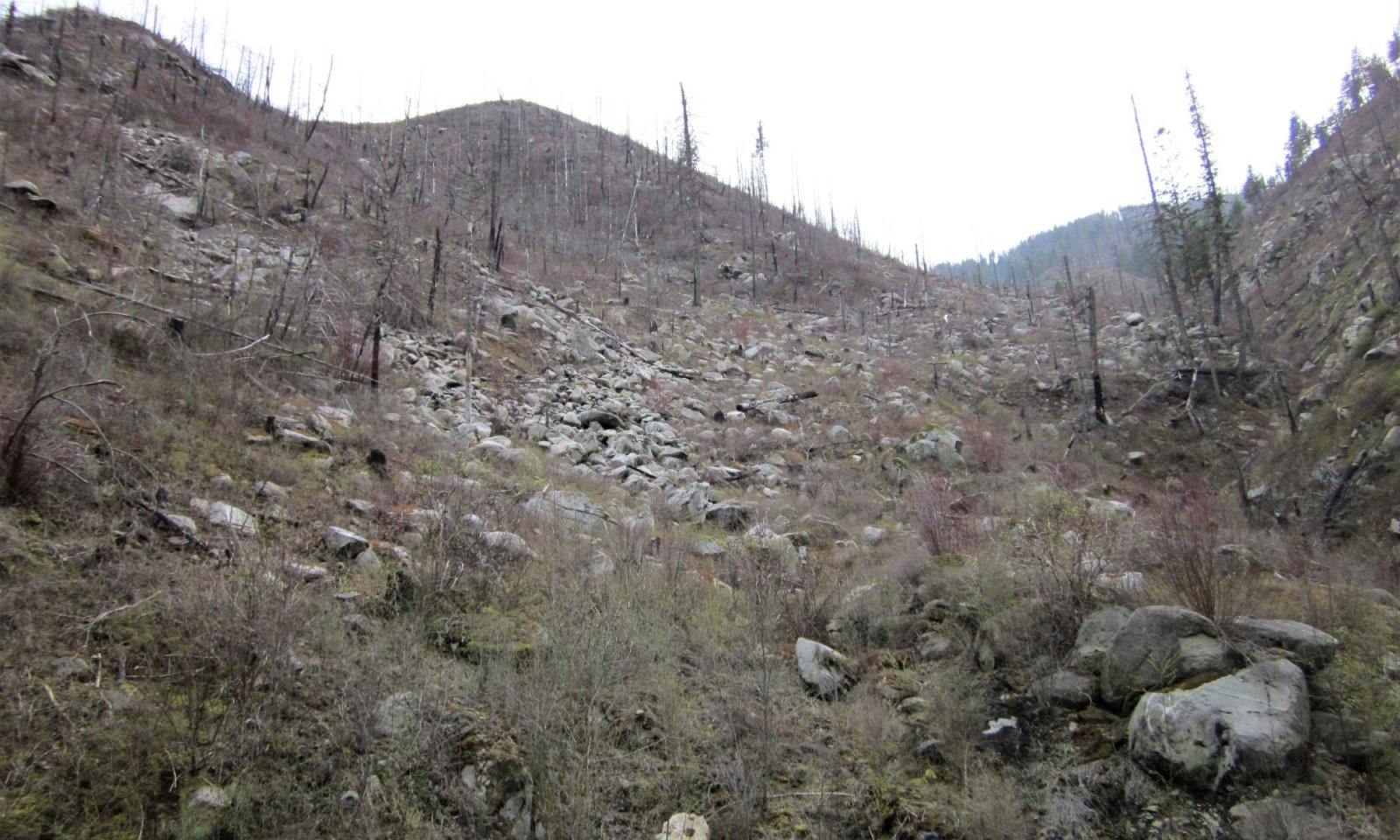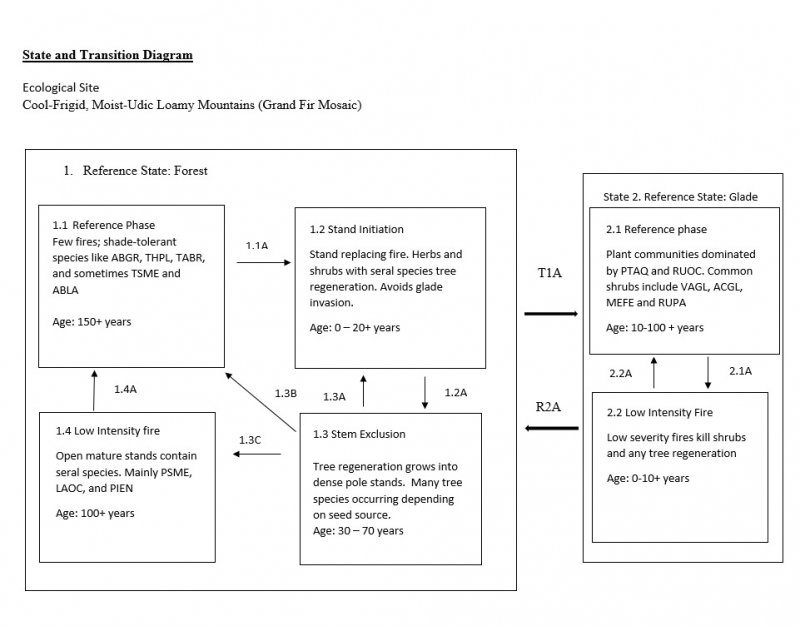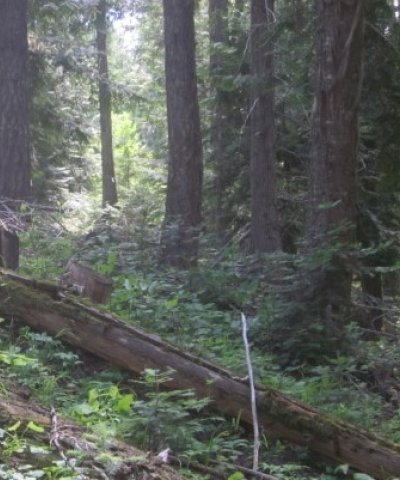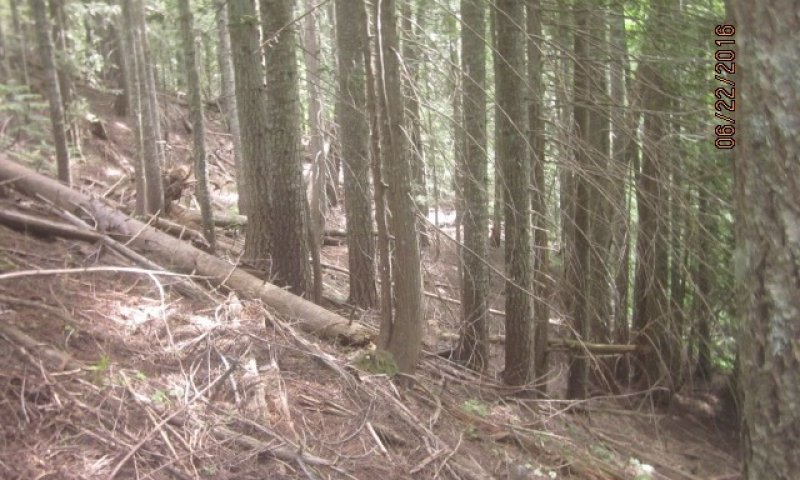Ecological dynamics
Ecological Dynamics of the Site
Grand Fir Mosaic habitats are found in upland forests that form drainages of the Clearwater River in northern Idaho and in the Blue Mountains of northeastern Oregon. The Grand Fir Mosaic (GFM) is named for the dominant conifer, grand fir (Abies grandis), and the variety of sizes and shapes of natural openings in the forest canopy (Ferguson and Johnson 1996). Dominant species in natural openings are Sitka alder (Alnus sinuata ), bracken fern (Pteridium aquilinum), and fool’s huckleberry (Menziesia ferruginea). The bulk of this ecological site occurs in the Clearwater River drainage.
The species composition of conifers in the GFM differs from non-Mosaic habitats (Ferguson and Johnson 1996). Grand fir is found most often, followed by Engelmann spruce (Picea engelmannii), subalpine fir (Abies lasiocarpa ), and Douglas-fir (Pseudotsuga menziesii var. glauca). Western white pine (Pinus monticola) and western larch (Larix occidentalis.) are found infrequently in northern Idaho. Elevations in the GFM are generally too high for ponderosa pine (Pinus ponderosa). Western redcedar (Thuja plicata) and mountain hemlock (Tsuga mertensiana) are found in certain parts of the GFM in Idaho. Of special note is the absence of lodgepole pine (Pinus contorta), which is found in higher and lower elevation forests adjacent to the GFM, but rarely in the GFM.
Key understory species include Douglas maple, serviceberry, twinflower, thimbleberry, pacific yew, mountain ash, common snowberry, wood rose, sitka alder, queencup beadlily, wild ginger, Idaho goldthread, western meadowrue, pathfinder, Hooker fairybells, mountain arnica, western coneflower, Canada violet, Ladyfern, bracken fern, Columbia brome, Ross sedge and tall trisetum.
State 1
Reference
These are climax plant communities that persist within a matrix of overmature grand fir (Abies grandis) and western redcedar (Thuja plicata) forests and tree islands. There are few wildfires, so natural succession has reduced the occurrence of seral conifers such as lodgepole pine (Pinus contorta), Douglas-fir (Pseudotsuga menziesii), western white pine (Pinus monticola), and western larch (Larix occidentalis). Late successional, shade-tolerant species like grand fir, western redcedar, Pacific yew (Taxus brevifolia), and sometimes mountain hemlock (Tsuga mertensiana) and subalpine fir (Abies lasiocarpa), are common along with mid-successional Engelmann spruce (Picea engelmannii). Regeneration of conifers in forest canopy openings is a slow and unreliable process in these low pH volcanic ash-cap soils that have abundant populations of pocket gophers (Thomomys talpoides). Disjunct and rare plant species occur in and near these forests, including evergreen synthyris (Synthyris platycarpa), Oregon bluebell (Mertensia bella), Dasynotus (Dasynotus daubenmirei), and Case’s corydalis (Corydalis caseana). Reoccurring severe fires in the can cause expansion of the glades into formerly forested areas. Fire exclusion for long periods allows the forest composition to move to late successional, shade-tolerant species like grand fir, western redcedar, Pacific yew (Taxus brevifolia), and sometimes mountain hemlock (Tsuga mertensiana) and subalpine fir (Abies lasiocarpa). However, succession does not lead to a reduction in size of glade areas
Community 1.1
Reference
Late successional, shade-tolerant species like grand fir, western redcedar, Pacific yew (Taxus brevifolia), and sometimes mountain hemlock (Tsuga mertensiana) and subalpine fir (Abies lasiocarpa), are common along with mid-successional Engelmann spruce (Picea engelmannii) and Douglas-fir (Pseudotsuga menziesii var. glauca). Western white pine (Pinus monticola) and western larch (Larix occidentalis.) are found infrequently. Regeneration of conifers in forest canopy openings is slow and unreliable.
Dominant plant species
-
grand fir (Abies grandis), tree
-
western redcedar (Thuja plicata), tree
-
Engelmann spruce (Picea engelmannii), tree
-
Rocky Mountain Douglas-fir (Pseudotsuga menziesii var. glauca), tree
-
Rocky Mountain maple (Acer glabrum), shrub
-
Saskatoon serviceberry (Amelanchier alnifolia), shrub
-
Oregon boxleaf (Paxistima myrsinites), shrub
-
white spirea (Spiraea betulifolia), shrub
-
thinleaf huckleberry (Vaccinium membranaceum), shrub
-
Scouler's willow (Salix scouleriana), shrub
-
Utah honeysuckle (Lonicera utahensis), shrub
-
Greene's mountain ash (Sorbus scopulina), shrub
-
red elderberry (Sambucus racemosa), shrub
-
Pacific yew (Taxus brevifolia), shrub
-
Columbia brome (Bromus vulgaris), grass
-
Ross' sedge (Carex rossii), grass
-
tall trisetum (Trisetum canescens), grass
-
American trailplant (Adenocaulon bicolor), other herbaceous
-
starry false lily of the valley (Maianthemum stellatum), other herbaceous
-
bride's bonnet (Clintonia uniflora), other herbaceous
-
western meadow-rue (Thalictrum occidentale), other herbaceous
-
British Columbia wildginger (Asarum caudatum), other herbaceous
-
Idaho goldthread (Coptis occidentalis), other herbaceous
-
Oregon drops of gold (Prosartes hookeri var. oregana), other herbaceous
-
mountain arnica (Arnica montana), other herbaceous
-
western coneflower (Rudbeckia occidentalis), other herbaceous
-
Canadian white violet (Viola canadensis), other herbaceous
Community 1.2
Stand Initiation
Herbs and shrubs reestablish on site. Ceanothus species can dominate if fire caused soil degradation. Tree regeneration can be mixed or dominated by western larch and lodgepole pine. Ponderosa pine and Douglas-fir can also be present. White pine was a major factor in regeneration before the blister rust reduced its significance. Site is in danger of glade assemblage invasion.
Community 1.3
Stem Exclusion
Dense stands of mixed seral species or dominated be larch or lodgepole pine. Douglas-fir, ponderosa pine, and western white pine can be in the stand.
Community 1.4
Low Severity Fires
Low severity fires create an open stand of mature Douglas-fir, Western larch, ponderosa pine, and lodgepole pine. Due to low fire frequency this phase is rare.
Pathway 1.1A
Community 1.1 to 1.2
Stand replacing fire back to the herbs and shrub stage. Regeneration dependent on seed source and brush competition.
Pathway 1.2A
Community 1.2 to 1.3
Tree regeneration grows into dense pole stand. Species can be mixed or dominated by larch or more rarely lodgepole pine.
Pathway 1.3B
Community 1.3 to 1.1
Mixed severity fires create patchy mosaic as in reference plant community phase 1.1.
Pathway 1.3A
Community 1.3 to 1.2
Stand replacing fire.
Pathway 1.3C
Community 1.3 to 1.4
Frequent low severity fires create open pole stands.
Pathway 1.4A
Community 1.4 to 1.1
Fire interval lengthens, and tree regeneration becomes established. Mixed severity fires create patchy mosaic of seral species and grand fir.
State 2
Glade

Figure 1. Reference State 2 (Glade) in foreground with Reference State 1 (Forest islands) in background.
(From Ferguson and Johnson. 1996.)
Severe fires or other historic disturbance creates glade openings. Successional plant communities in the GFM are dominated by bracken fern and western coneflower. Bracken fern is usually present in low densities under forest canopies, but rapidly expands following disturbance. Once established these communities are very persistent. They appear to be maintained by a combination of allelopathy, pocket gopher activity and changes in soil minerology and chemistry due to increased organic matter contribution
Community 2.1
Reference
Site biomass is dominated by Western coneflower (Rudbeckia occidentalis), Bracken fern (Pteridium aquilinum). Shrubs are present as scattered patches. Most frequent shrub species are: Douglas maple (Acer glabrum Douglasii), Blue huckleberry (Vaccinium globulare), Mock azalea (Menziesia ferruginea), and Thimbleberry (Rubus parviflorus). Most frequent forb species are: Starry solomonplume (Smilacina stellata), Queencup beadlily (Clintonia uniflora), Wild ginger (Asarum caudatum), and Idaho goldthread (Coptis occidentalis). Most frequent graminoids are: Columbia brome (Bromus vulgaris), and Ross sedge (Carex rosii).
Dominant plant species
-
Rocky Mountain maple (Acer glabrum), shrub
-
thinleaf huckleberry (Vaccinium membranaceum), shrub
-
rusty menziesia (Menziesia ferruginea), shrub
-
thimbleberry (Rubus parviflorus), shrub
-
Columbia brome (Bromus vulgaris), grass
-
Ross' sedge (Carex rossii), grass
-
western brackenfern (Pteridium aquilinum), other herbaceous
-
western coneflower (Rudbeckia occidentalis), other herbaceous
-
starry false lily of the valley (Maianthemum stellatum), other herbaceous
-
bride's bonnet (Clintonia uniflora), other herbaceous
-
British Columbia wildginger (Asarum caudatum), other herbaceous
Community 2.2
Disturbance
Site is forb dominated with shrubs reduced or eliminated and coniferous regeneration killed. Temporary occupation of significant portions of the site by early successional forbs such as fireweed (Chamerion angustifolium) may occur.
Pathway 2.1A
Community 2.1 to 2.2
Low severity fires kill some shrubs and any tree regeneration. Roots of coneflower and bracken fern are often able to survive to resprout. Any shrubs present are burned back but also may be prepared to sprout from root collars if fire severity is low enough.
Pathway 2.2A
Community 2.2 to 2.1
Time and regrowth allows restoration of pre-disturbance glade community.
Transition T1A
State 1 to 2
Severe burns kill regeneration and allow for invasion and expansion of glade assemblage species. Presence of bracken fern and other glade species in pre-fire understory provides opportunity for rapid site colonization. Pocket gopher activity increases with proliferation of bracken fern.
Restoration pathway R2A
State 2 to 1
Careful site selection with fire control and forb suppression allow tree regeneration to establish. This is very difficult to accomplish.







